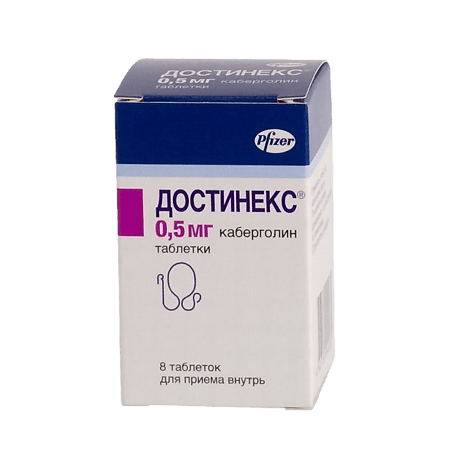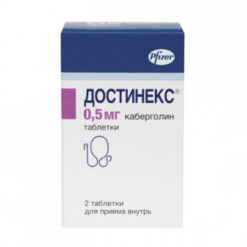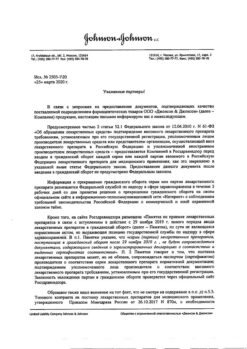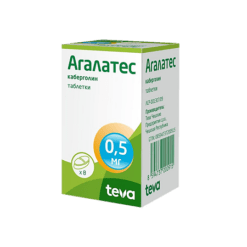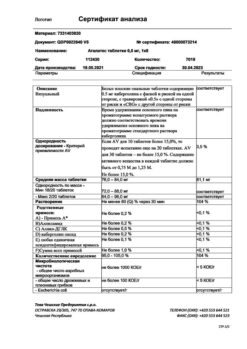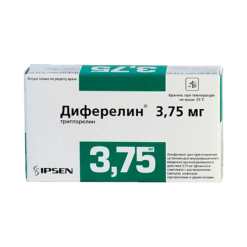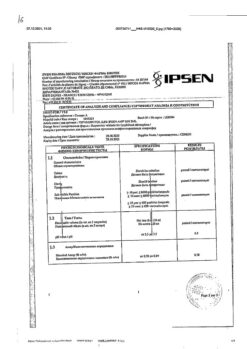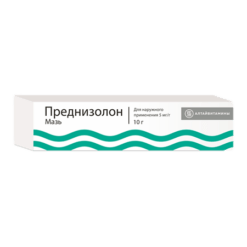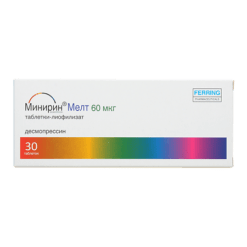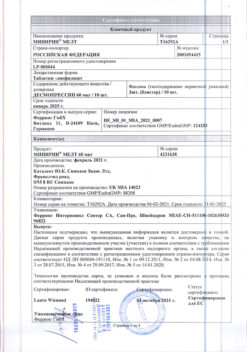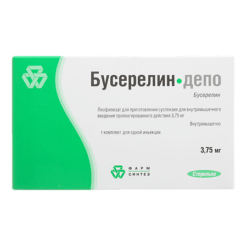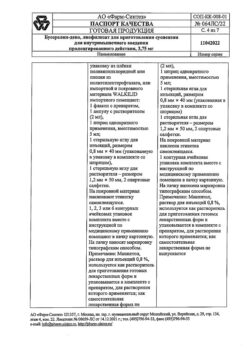No products in the cart.
Dostinex, tablets 0.5 mg 8 pcs
€80.89 €70.11
Description
Dopamine receptor agonist. Cabergoline is a dopaminergic derivative of ergoline, characterized by a pronounced and long-lasting prolactin-lowering effect.
The mechanism of action is connected with direct stimulation of dopamine D2-receptors of lactotropic cells of the pituitary. In doses higher than those for reduction of plasma prolactin levels it has central dopaminergic action caused by stimulation of dopamine D2-receptors.
Decrease of prolactin level in plasma is noticed in 3 hours after Dostinex usage and is maintained during 7-28 days in healthy volunteers and patients with hyperprolactinemia and up to 14-21 days in women in postpartum period. The prolactin-lowering effect is dose-dependent with respect to both the severity and duration of action.
Cabergoline is highly selective and therefore has no effect on basal secretion of other pituitary hormones as well as cortisol.
The non-therapeutic pharmacological effects of cabergoline include a decrease in BP. With single use of the drug, the maximum hypotensive effect is seen during the first 6 h and is dose-dependent.
Pharmacokinetics
Intake
After oral administration, cabergoline is rapidly absorbed from the gastrointestinal tract. Cmax in plasma is reached after 0.5-4 hours. Food intake has no effect on absorption and distribution of cabergoline.
Distribution
The Css is reached after 4 weeks of therapy due to the long T1/2. Binding to plasma proteins is 41-42%.
Metabolism
The main metabolic product of cabergoline identified in the urine is 6-allyl-8β-carboxy-ergoline at concentrations up to 4-6% of the dose taken. The urinary content of 3 additional metabolites does not exceed 3% of the administered dose. The metabolic products have significantly less effect on suppressing prolactin secretion compared to cabergoline.
Elimation
The T1/2, estimated by urinary excretion rate, is 63-68 h in healthy volunteers and 79-115 h in patients with hyperprolactinemia.
In 10 days after the use of the drug, 18% and 72% of the administered dose are detected in the urine and feces, respectively, and the proportion of unchanged drug in the urine is 2-3%.
Indications
Indications
menstrual irregularities
female infertility
to suppress lactation (after childbirth or abortion)
pituitary tumors.
Pharmacological effect
Pharmacological effect
Dopamine receptor agonist. Cabergoline is a dopaminergic derivative of ergoline, characterized by a pronounced and long-lasting prolactin-lowering effect.
The mechanism of action is associated with direct stimulation of dopamine D2 receptors of lactotropic cells of the pituitary gland. In doses exceeding those for reducing the level of prolactin in the blood plasma, it has a central dopaminergic effect due to stimulation of dopamine D2 receptors.
A decrease in the level of prolactin in the blood plasma is observed 3 hours after taking Dostinex and persists for 7-28 days in healthy volunteers and patients with hyperprolactinemia and up to 14-21 days in women in the postpartum period. The prolactin-lowering effect is dose-dependent both in terms of severity and duration of action.
Cabergoline has a strictly selective effect and, therefore, does not affect the basal secretion of other pituitary hormones, as well as cortisol.
The pharmacological effects of cabergoline that are not associated with a therapeutic effect include a decrease in blood pressure. With a single use of the drug, the maximum hypotensive effect is observed during the first 6 hours and is dose-dependent.
Pharmacokinetics
Suction
After oral administration, cabergoline is rapidly absorbed from the gastrointestinal tract. Cmax in plasma is reached after 0.5-4 hours. Food intake does not affect the absorption and distribution of cabergoline.
Distribution
Css is achieved after 4 weeks of therapy due to a long T1/2. Plasma protein binding is 41-42%.
Metabolism
The main product of cabergoline metabolism identified in urine is 6-allyl-8β-carboxy-ergoline at concentrations up to 4-6% of the dose taken. The content of 3 additional metabolites in the urine does not exceed 3% of the dose taken. Metabolic products have a significantly lesser effect in suppressing prolactin secretion compared to cabergoline.
Removal
T1/2, estimated by the rate of excretion in urine, is 63-68 hours in healthy volunteers and 79-115 hours in patients with hyperprolactinemia.
10 days after using the drug, 18% and 72% of the dose taken are found in urine and feces, respectively, with the proportion of unchanged drug in urine being 2-3%.
Special instructions
Special instructions
After selecting an effective dosage regimen, it is recommended to regularly (once a month) determine the level of prolactin in the blood serum. Normalization of prolactin levels is usually observed within 2-4 weeks of treatment.
Dostinex is prescribed with caution to patients with cardiovascular diseases, Raynaud’s syndrome, peptic ulcers or gastrointestinal bleeding, as well as patients with a history of severe mental illness, especially psychosis.
Dostinex should be prescribed with caution during therapy with drugs that have a hypotensive effect.
For long-term therapy, Dostinex should be prescribed in lower doses to patients with severe liver failure.
After discontinuation of Dostinex, a relapse of hyperprolactinemia is usually observed. However, some patients experience persistent suppression of prolactin levels for several months. Most women experience ovulatory cycles for at least 6 months after discontinuation of Dostinex.
Dostinex should not exceed a single dose of 0.25 mg in nursing mothers undergoing treatment aimed at suppressing established lactation in order to prevent the occurrence of orthostatic hypotension.
Before starting Dostinex therapy, a complete study of pituitary function is indicated.
Dostinex restores ovulation and fertility in women with hyperprolactinemic hypogonadism. Since pregnancy can occur even before the return of menstruation, it is recommended to carry out pregnancy tests at least once every 4 weeks during the amenorrhea period, and after the return of menstruation – whenever a delay of more than 3 days is noted. Women who want to avoid pregnancy should use non-hormonal methods of contraception during the period of treatment with Dostinex, as well as after discontinuation of Dostinex and until anovulation returns.
Women who become pregnant should be under medical supervision to promptly identify symptoms of an enlarged pituitary gland, since pre-existing pituitary tumors may increase in size during pregnancy.
Side effects associated with taking the drug are dose-dependent. The likelihood of side effects can be reduced if Dostinex therapy is started at lower doses (for example, 0.25 mg once a week), followed by a gradual increase in dose until the therapeutic dose level is reached. If persistent or severe side effects occur, a temporary dose reduction followed by a more gradual increase (eg, an increase of 0.25 mg per week every 2 weeks) will improve tolerability.
With long-term therapy with Dostinex, deviations from the norm in standard laboratory tests are not typical; Women with amenorrhea experienced a decrease in hemoglobin levels during the first few months after the return of menstruation.
Active ingredient
Active ingredient
Cabergoline
Composition
Composition
Active ingredient:
cabergoline 500 mcg;
Excipients:
leucine;
lactose anhydrous.
Contraindications
Contraindications
Hypersensitivity, postpartum psychosis.
Side Effects
Side Effects
From the cardiovascular system: heartbeat; rarely – orthostatic hypotension (with long-term use, Dostinex® usually has a hypotensive effect); an asymptomatic decrease in blood pressure is possible during the first 3–4 days after birth (sBP by more than 20 mm Hg, dBP by more than 10 mm Hg).
From the nervous system: dizziness/vertigo, headache, fatigue, drowsiness, depression, asthenia, paresthesia, fainting.
From the digestive system: nausea, vomiting, pain in the epigastric region, abdominal pain, constipation, gastritis, dyspepsia.
Other: mastodynia, nosebleeds, flushing of the face, transient hemianopsia, spasms of blood vessels in the fingers and muscle cramps of the lower extremities (like other ergot derivatives, Dostinex® may have a vasoconstrictor effect).
Interaction
Interaction
There is no information on interactions between cabergoline and ergot alkaloids; however, the simultaneous use of these drugs during long-term therapy with Dostinex is not recommended.
When used simultaneously with phenothiazine derivatives, butyrophenone, thioxanthene, and metoclopramide, a weakening of the effect of Dostinex is observed.
When Dostinex is used simultaneously with antibiotics from the macrolide group, the risk of side effects increases, since this can lead to an increase in the systemic bioavailability of cabergoline.
Overdose
Overdose
Symptoms: nausea, vomiting, dyspeptic disorders, orthostatic hypotension, confusion/psychosis or hallucinations.
Treatment: measures should be taken aimed at removing unabsorbed drug (gastric lavage) and maintaining blood pressure. It is recommended to prescribe dopamine antagonists.
Storage conditions
Storage conditions
At a temperature not exceeding 25 °C
Shelf life
Shelf life
2 years
Manufacturer
Manufacturer
Pfizer Italy S.r.L., Italy
Additional information
| Shelf life | 2 years |
|---|---|
| Conditions of storage | At a temperature not exceeding 25 °C |
| Manufacturer | Pfizer Italy S.r.l., Italy |
| Medication form | pills |
| Brand | Pfizer Italy S.r.l. |
Other forms…
Related products
Buy Dostinex, tablets 0.5 mg 8 pcs with delivery to USA, UK, Europe and over 120 other countries.

